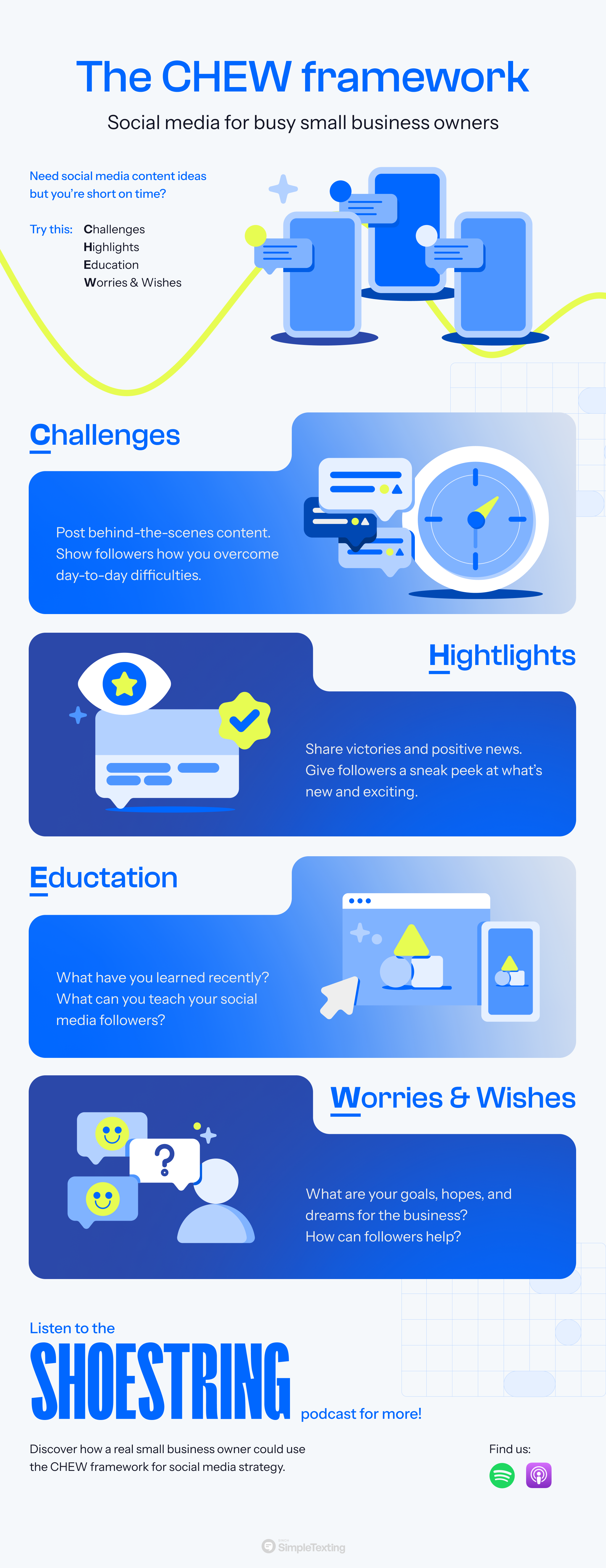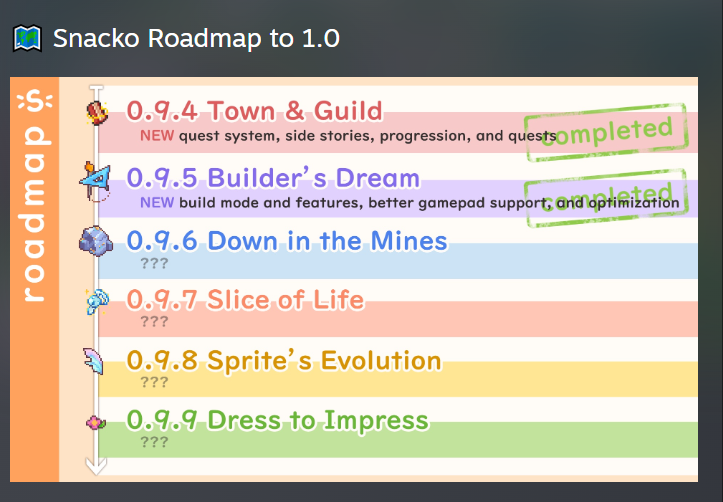The CHEW framework: A social media strategy for small business
Coming up with ideas for social media as a business owner can be tough. Try this social media framework that's based on the concept of "building in public."

Coming up with ideas for social media as a business owner can be tough. Try this social media framework that's based on the concept of "building in public."

How’s your small business social media strategy going? If you’re like many small business owners, you already have a lot on your plate. There may not be much room in your overworked brain for social media post ideas.
Chances are – your marketing team is either very small or you are the marketing team.
So, how do you get your company out there when you’re trying to do it all with few resources? Our social media strategy for small businesses will make content creation second nature, giving you more time and brainpower to focus on other parts of your business.
This social media framework came about when we helped a small business owner on our Shoestring podcast. Keep reading to learn how it started and how you can use it to power your strategy.
Oriana owns Sao New York, a home goods business featuring products from artisans across the world. As she puts it, “Every item has a story, has a purpose. Sao is kind of like a reflection of me and my values as a person, and I wanted to share that with people.”
That’s a promising place to start. Oriana offers products that have stories behind them. Her business has a purpose. She wants to share these things with her audience. What she needs are time and ideas.

Since she takes care of all of Sao’s operations on top of another job, it’s hard for Oriana to find time to do social media marketing. She teamed up with branding experts to put together a professional website and marketing strategy, but she’s often too busy to turn their advice into ongoing social content. So, she contacted Shoestring to for some advice.
Alfredo Salkeld, the host of Shoestring, had an idea to make it easier for Oriana to come up with social media content ideas.
After seeing content based on “building in public” on his Instagram feed, Alfredo came up with the CHEW framework. “Building in public” posts showcase how a business runs and grows. CHEW is an acronym that outlines four ways to share this type of content.
Check our our infographic for more on using the CHEW social media framework…

Using the CHEW framework, Oriana and businesses like yours can:
Best of all, CHEW helps social media post ideas come more naturally. When you follow this framework, you can create a content bank from your day-to-day operations. “Filming things as they happen is way easier than meticulously planning each video frame by frame,” Alfredo says.
What you’re looking for is what Alfredo calls “micro stories.” Good social media content is all about little stories that resonate with the people you want to reach. When you apply the CHEW framework, you’ve got a small business social media strategy that has amazing ideas built right in.
Let’s break down each letter in the framework and what it looks like in real posts from other small businesses.
Every small business has everyday challenges to face, and you can turn them into opportunities by sharing them with your audience. You’ll build authenticity through vulnerability and show how you can handle whatever entrepreneurship throws at you.
For example, Tacos Don Perez, a Mexican restaurant with catering services, shared how their team manages larger orders – in this case, one involving 200 people. One of their staff narrated the process that goes into such a big catering job and showed how the team works as a family to achieve their goals.
The cat rescue organization Flatbush Cats showed how this letter of the framework can work for nonprofits. It often tells the stories of the cats it rescues and the challenges the volunteers and those cats face throughout the process. These posts make a case for why Flatbush Cats needs support from donors and raises awareness about cats that need help in Brooklyn.
You don’t always have to focus on the difficulties in your business, though – successes have a place in your content, too, as highlights. Showcase your wins and celebrate your accomplishments, whether you got new equipment for your kitchen or signed a contract with a big brand. This content type also serves as a great way to announce and promote new offerings.
Mala, an independent candle company, often shares its accomplishments with its Instagram audience. When the brand shared a candle release at a Hong Kong luxury retailer, it also mentioned a loss that came with the win after that idea succeeded in another post. Don’t be afraid to mix content that matches different letters in the framework – in fact, it can add more dimension to your story.
The regional restaurant chain Rasa offered an on-the-scene look at its appearance at the Smithsonian National Museum of Asian Art for Diwali. This Reel celebrated their accomplishment and spread the word so customers could stop by to try their food.
Running a small business involves a lot of learning as you go. Why not create some educational posts so your audience can learn with you? This content could explain what you learned from your experience as a small business owner or pass that knowledge onto the audience.
For instance, the noodle brand Omsom shared what its team learned when their business got acquired. Most of its audience won’t need to use this information, but it shows the human side of the experience.
And in business coach Jenni Gritters’ case, many of the things she learns as a business owner also help her potential clients. Many of her LinkedIn posts share how she learns and grows and what you can take away from it. She’s also open about the fact that she repurposes her content, meaning you can follow her lead and repurpose your own CHEW posts.
The first three letters in CHEW cover the past and present, but this last one centers around the future. What business goals could you share with your audience, and what are your feelings surrounding them? This content type provides a great opening for customer feedback, such as when the taiyaki business Rice Culture brought up the idea of returning to farmer’s market booths. It was able to learn what locations its followers wanted them to visit and stay transparent with them. Thanks to that planning, the booths became a hit.
Another idea that comes to my mind doesn’t necessarily pop up on my social media video feeds, but it could work well for it. Some of the indie video games I follow also take a “building in public” approach by sharing roadmaps for future updates. Take Snacko, a game still preparing for official release, as an example.

This roadmap shows the features planned for the upcoming versions of the game. But even if you don’t sell a video game, you can make a roadmap for your business. What products, services, or expansions do you hope to release in the future? Walk your followers through your roadmap and keep the details a mystery to spark their curiosity.
With so many other tasks on your to-do list, it can be hard to justify investing some of your time in social media, especially when it can feel like a pay-to-win situation. As Mailjet mentioned in its report, organic social media reach is down due to the rise of ads. But that doesn’t mean social media is dead – it just has a new purpose now.
While lower reach makes it more difficult to send social media users to your website, you can still benefit from the connections you can make with them. In our 2024 study on small business marketing, we found that 31% of consumers use social media to find new small businesses. So, the reach you can get matters and so does your ability to be found on social media. It’s not just about your posts, it’s about your presence.
Plus, social media still has a huge number of users for you to reach. According to our 2024 small business marketing study, 68% of consumers use social media every day. And it’s Generation Z’s favorite channel by far, making it especially important for businesses looking to bring in younger customers.
Instead of writing off social media, small businesses like yours can focus on what SparkToro calls zero-click content. This content offers value on its own without the reader needing to click, hence the name. The CHEW framework can help you make this type of content to connect with your customers and build trust with them.
Although social media works well for brand awareness and discovery, you can get the best results out of your marketing by adding more channels to the mix. SMS marketing complements social media well by filling in its gaps. It offers a direct line of communication to your customers where you don’t have to worry about an algorithm.
I know that adding another channel gives you another to-do to check off, but just like with social media, we have a framework for you to use with texting: PASTA. PASTA saves you time by spelling out the types of text messages you can send as a business:
Another way to save time with SMS marketing is to use a service like SimpleTexting. SimpleTexting has features like scheduled texts and an AI writing assistant to put your texting on autopilot. Give it a try today in our 14-day free trial.
Melissa writes thoughtful content about marketing and productivity for B2B SaaS companies like CoSchedule, Zapier, and Databox. She has six years of professional writing experience. Outside of the content marketing world, she sometimes writes about video games.
More Posts from Melissa KingUse these Memorial Day text message templates and best practices to get customers excited about your sales and promotions.
ReadUnsubsribes happen, but the key to a successful campaign is understanding why. Learn how to manage your opt outs and keep subscribers happy.
ReadStart a text marketing campaign or have a 1-on-1 conversation today. It's risk free. Sign up for a free 14-day trial today to see SimpleTexting in action.
No credit card required